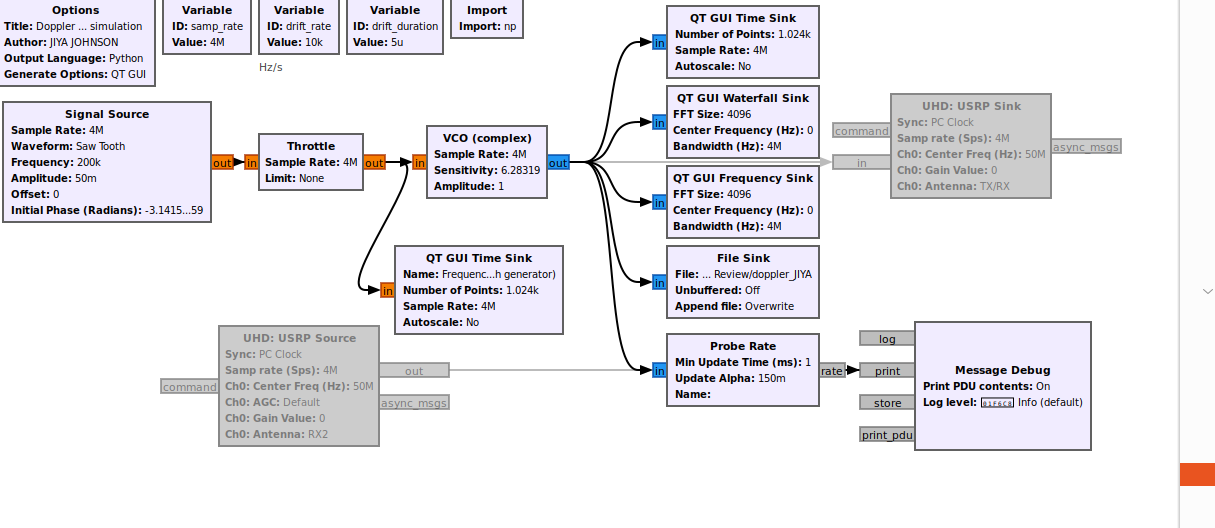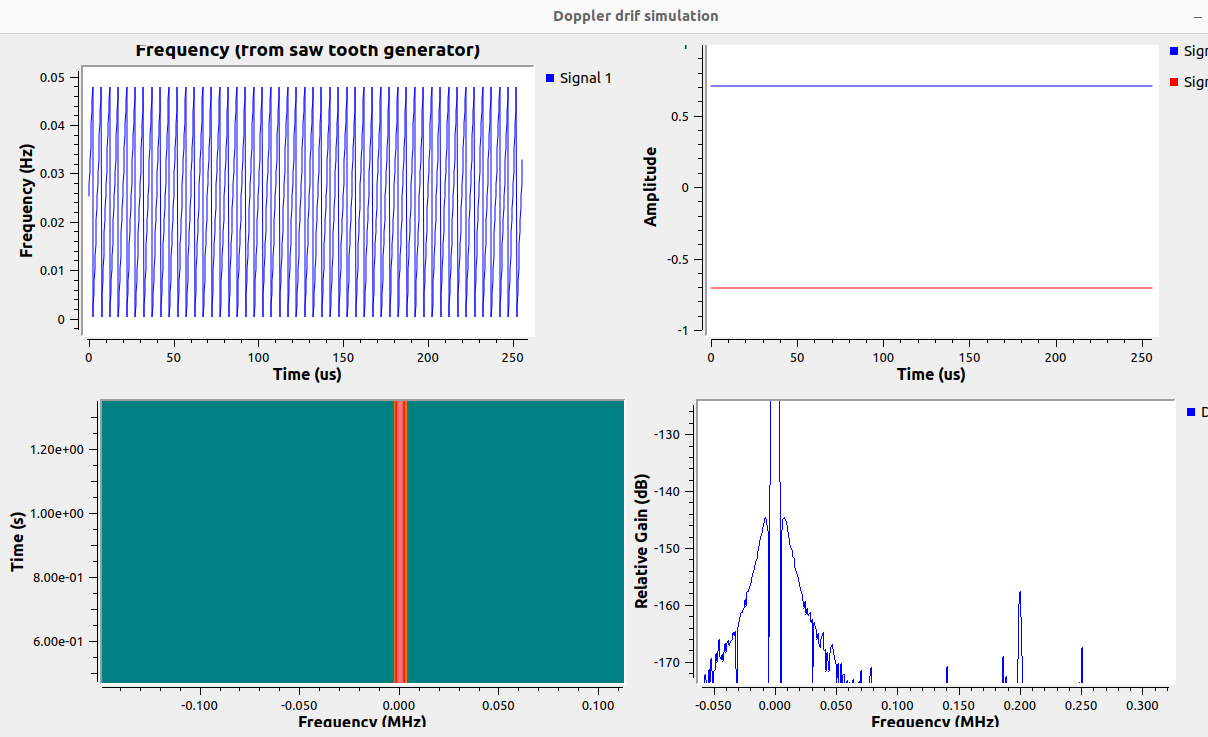How can I evaluate (validate) the settings I have given to set the Doppler
freq of 200khz and Doppler rate of 10khz/s is correct
On Sun, Jan 7, 2024, 5:30 PM
Jiya Johnson <jiyajohnson10@gmail.com>
wrote:
How can I evaluate (validate) the settings I have given to set the Doppler freq of 200khz and Doppler rate of 10khz/s is correct.
On Thu, Jan 4, 2024, 11:00 AM Jiya Johnson <jiyajohnson10@gmail.com> wrote:
My requirement is to set Doppler frequency of 200KHz and Doppler rate 10KHz/s
Comments required
On Tue, Jan 2, 2024 at 9:59 AM Jiya Johnson <jiyajohnson10@gmail.com> wrote:
Greetings all,Let's say if I want to do it for Doppler frequency of 200KHz and Doppler rate 10KHz/s is it possible to do with USRP hardware simulations.
On Tue, Jan 2, 2024 at 7:17 AM <discuss-gnuradio-request@gnu.org> wrote:
Send Discuss-gnuradio mailing list submissions to
discuss-gnuradio@gnu.org
To subscribe or unsubscribe via the World Wide Web, visit
https://lists.gnu.org/mailman/listinfo/discuss-gnuradio
or, via email, send a message with subject or body 'help' to
discuss-gnuradio-request@gnu.org
You can reach the person managing the list at
discuss-gnuradio-owner@gnu.org
When replying, please edit your Subject line so it is more specific
than "Re: Contents of Discuss-gnuradio digest..."
Today's Topics:
1. Re: Doppler (Marcus D. Leech)
2. Re: Doppler (Jeff Long)
3. Re: Doppler (Marcus D. Leech)
----------------------------------------------------------------------
Message: 1
Date: Mon, 1 Jan 2024 20:31:57 -0500
From: "Marcus D. Leech" <patchvonbraun@gmail.com>
To: discuss-gnuradio@gnu.org
Subject: Re: Doppler
Message-ID: <e81603a8-6e4b-4f63-8fc5-b1f007f92e66@gmail.com" rel="noreferrer noreferrer" target="_blank" moz-do-not-send="true" class="moz-txt-link-freetext">e81603a8-6e4b-4f63-8fc5-b1f007f92e66@gmail.com>
Content-Type: text/plain; charset="utf-8"; Format="flowed"
On 01/01/2024 20:28, Jeff Long wrote:
> The problem here is relating this kind of chirp to anything physical.
> As Daniel says, this may make sense for a synthesized signal. It's
> pretty easy to create any signal you want using some combination of
> Python and GNU Radio (or other tools). One possible problem could be
> specifying very large numbers for parameters in some programs.
The term "doppler" tends to imply in many engineer's minds some type of
actual physicality...
>
> On Mon, Jan 1, 2024 at 7:40 PM Marcus D. Leech
> <patchvonbraun@gmail.com> wrote:
>
> On 01/01/2024 16:11, Marcus Müller wrote:
>>
>> Liya,
>>
>> Doppler shift Δf is proportional to both speed and carrier
>> frequency /f/₀
>>
>> Δ/f/ = /f/₀ · /v///c/₀,
>>
>> where /v/ is the relative speed of your thing, and /c/₀ is the
>> speed of light.
>>
>> The highest frequencies we can, so far, do radio communications
>> on, are in the range of f₀=150 GHz.
>>
>> So, assuming you do communications on 150 GHz, for your Doppler
>> shift to be Δ/f=/10 GHz higher after 1s, your acceleration must been
>>
>> /a = /Δ/f / f/₀ · /c/₀ / 1s = 10 GHz / 150 GHz · 3·10⁸ m/s / s =
>> 2/30 · 3·10⁸ m/s² = 1/15 /c/₀/s.
>>
>> The fastest object mankind has ever built is the Parker Solar
>> Probe, which will burn up while it spirals into the sun, at a
>> maximum velocity of ca 1/15 of the speed of light. It takes it
>> years to reach that speed, not 1s.
>>
>> So, you're assuming you're seeing a doppler from a satellite
>> rotating around earth that sees a relative acceleration higher
>> than a "satellite" around the sun actively being pulled into the
>> sun by the sun's immense gravity.
>>
>> That sadly makes no physical sense!
>>
>> Best regards,
>> Marcus
>>
> C/15 is actually about *twice* as fast as the fastest object we
> will ever have made.
>
>
>> On 01.01.24 07:51, Jiya Johnson wrote:
>>> Yes I want to use 10GHz/s
>>>
>>> On Sat, Dec 30, 2023, 4:05 PM Jiya Johnson
>>> <jiyajohnson10@gmail.com> wrote:
>>>
>>> Greetings everyone,
>>> https://github.com/daniestevez/reu-2023/tree/main/doppler
>>> I went through these grc files and tried to do
>>> drift_simulation, i am not getting the way to get 10GHz/s
>>> using inspectrum and frequency sink slope calculation i have
>>> attached the grc and screenshots.
>>> image.png
>>> image.png
>>>
>
-------------- next part --------------
An HTML attachment was scrubbed...
URL: <https://lists.gnu.org/archive/html/discuss-gnuradio/attachments/20240101/934e8c35/attachment.htm>
-------------- next part --------------
A non-text attachment was scrubbed...
Name: image.png
Type: image/png
Size: 194533 bytes
Desc: not available
URL: <https://lists.gnu.org/archive/html/discuss-gnuradio/attachments/20240101/934e8c35/attachment.png>
-------------- next part --------------
A non-text attachment was scrubbed...
Name: image.png
Type: image/png
Size: 111344 bytes
Desc: not available
URL: <https://lists.gnu.org/archive/html/discuss-gnuradio/attachments/20240101/934e8c35/attachment-0001.png>
------------------------------
Message: 2
Date: Mon, 1 Jan 2024 20:40:45 -0500
From: Jeff Long <willcode4@gmail.com>
To: discuss-gnuradio@gnu.org
Subject: Re: Doppler
Message-ID:
<CAC5f9jaHEUR6PdmCFAEHQdaGnjh9oKiL+dLudWNEORf2sSyyUA@mail.gmail.com>
Content-Type: text/plain; charset="utf-8"
Doppler also applies to lasers.
On Mon, Jan 1, 2024 at 8:32 PM Marcus D. Leech <patchvonbraun@gmail.com>
wrote:
> On 01/01/2024 20:28, Jeff Long wrote:
>
> The problem here is relating this kind of chirp to anything physical.
> As Daniel says, this may make sense for a synthesized signal. It's pretty
> easy to create any signal you want using some combination of Python and GNU
> Radio (or other tools). One possible problem could be specifying very large
> numbers for parameters in some programs.
>
> The term "doppler" tends to imply in many engineer's minds some type of
> actual physicality...
>
>
>
> On Mon, Jan 1, 2024 at 7:40 PM Marcus D. Leech <patchvonbraun@gmail.com>
> wrote:
>
>> On 01/01/2024 16:11, Marcus Müller wrote:
>>
>> Liya,
>>
>> Doppler shift Δf is proportional to both speed and carrier frequency *f*₀
>>
>> Δ*f* = *f*₀ · *v*/*c*₀,
>>
>> where *v* is the relative speed of your thing, and *c*₀ is the speed of
>> light.
>>
>> The highest frequencies we can, so far, do radio communications on, are
>> in the range of f₀=150 GHz.
>>
>> So, assuming you do communications on 150 GHz, for your Doppler shift to
>> be Δ*f=*10 GHz higher after 1s, your acceleration must been
>>
>> *a = *Δ*f / f*₀ · *c*₀ / 1s = 10 GHz / 150 GHz · 3·10⁸ m/s / s = 2/30 ·
>> 3·10⁸ m/s² = 1/15 *c*₀/s.
>>
>> The fastest object mankind has ever built is the Parker Solar Probe,
>> which will burn up while it spirals into the sun, at a maximum velocity of
>> ca 1/15 of the speed of light. It takes it years to reach that speed, not
>> 1s.
>>
>> So, you're assuming you're seeing a doppler from a satellite rotating
>> around earth that sees a relative acceleration higher than a "satellite"
>> around the sun actively being pulled into the sun by the sun's immense
>> gravity.
>>
>> That sadly makes no physical sense!
>>
>> Best regards,
>> Marcus
>>
>> C/15 is actually about *twice* as fast as the fastest object we will ever
>> have made.
>>
>>
>> On 01.01.24 07:51, Jiya Johnson wrote:
>>
>> Yes I want to use 10GHz/s
>>
>> On Sat, Dec 30, 2023, 4:05 PM Jiya Johnson <jiyajohnson10@gmail.com>
>> wrote:
>>
>>> Greetings everyone,
>>> https://github.com/daniestevez/reu-2023/tree/main/doppler
>>> I went through these grc files and tried to do drift_simulation, i am
>>> not getting the way to get 10GHz/s using inspectrum and frequency sink
>>> slope calculation i have attached the grc and screenshots.
>>> [image: image.png]
>>> [image: image.png]
>>>
>>>
>>
>
-------------- next part --------------
An HTML attachment was scrubbed...
URL: <https://lists.gnu.org/archive/html/discuss-gnuradio/attachments/20240101/bc2fb883/attachment.htm>
-------------- next part --------------
A non-text attachment was scrubbed...
Name: image.png
Type: image/png
Size: 194533 bytes
Desc: not available
URL: <https://lists.gnu.org/archive/html/discuss-gnuradio/attachments/20240101/bc2fb883/attachment.png>
-------------- next part --------------
A non-text attachment was scrubbed...
Name: image.png
Type: image/png
Size: 111344 bytes
Desc: not available
URL: <https://lists.gnu.org/archive/html/discuss-gnuradio/attachments/20240101/bc2fb883/attachment-0001.png>
------------------------------
Message: 3
Date: Mon, 1 Jan 2024 20:46:47 -0500
From: "Marcus D. Leech" <patchvonbraun@gmail.com>
To: discuss-gnuradio@gnu.org
Subject: Re: Doppler
Message-ID: <92e54bd6-9165-48d0-ad43-861ad4d3553e@gmail.com" rel="noreferrer noreferrer" target="_blank" moz-do-not-send="true" class="moz-txt-link-freetext">92e54bd6-9165-48d0-ad43-861ad4d3553e@gmail.com>
Content-Type: text/plain; charset="utf-8"; Format="flowed"
On 01/01/2024 20:40, Jeff Long wrote:
> Doppler also applies to lasers.
Well, OK. Maybe we're not talking radio at all here. Wouldn't be the
first time Gnu Radio has been used for
other parts of the EM (and even non-EM) spectrum.
I'm not really up to date on the state of optics and optical/RF
interfaces, so, maybe I'll learn something...
>
> On Mon, Jan 1, 2024 at 8:32 PM Marcus D. Leech
> <patchvonbraun@gmail.com> wrote:
>
> On 01/01/2024 20:28, Jeff Long wrote:
>> The problem here is relating this kind of chirp to anything
>> physical. As Daniel says, this may make sense for a synthesized
>> signal. It's pretty easy to create any signal you want using some
>> combination of Python and GNU Radio (or other tools). One
>> possible problem could be specifying very large numbers for
>> parameters in some programs.
> The term "doppler" tends to imply in many engineer's minds some
> type of actual physicality...
>
>
>>
>> On Mon, Jan 1, 2024 at 7:40 PM Marcus D. Leech
>> <patchvonbraun@gmail.com> wrote:
>>
>> On 01/01/2024 16:11, Marcus Müller wrote:
>>>
>>> Liya,
>>>
>>> Doppler shift Δf is proportional to both speed and carrier
>>> frequency /f/₀
>>>
>>> Δ/f/ = /f/₀ · /v///c/₀,
>>>
>>> where /v/ is the relative speed of your thing, and /c/₀ is
>>> the speed of light.
>>>
>>> The highest frequencies we can, so far, do radio
>>> communications on, are in the range of f₀=150 GHz.
>>>
>>> So, assuming you do communications on 150 GHz, for your
>>> Doppler shift to be Δ/f=/10 GHz higher after 1s, your
>>> acceleration must been
>>>
>>> /a = /Δ/f / f/₀ · /c/₀ / 1s = 10 GHz / 150 GHz · 3·10⁸ m/s /
>>> s = 2/30 · 3·10⁸ m/s² = 1/15 /c/₀/s.
>>>
>>> The fastest object mankind has ever built is the Parker
>>> Solar Probe, which will burn up while it spirals into the
>>> sun, at a maximum velocity of ca 1/15 of the speed of light.
>>> It takes it years to reach that speed, not 1s.
>>>
>>> So, you're assuming you're seeing a doppler from a satellite
>>> rotating around earth that sees a relative acceleration
>>> higher than a "satellite" around the sun actively being
>>> pulled into the sun by the sun's immense gravity.
>>>
>>> That sadly makes no physical sense!
>>>
>>> Best regards,
>>> Marcus
>>>
>> C/15 is actually about *twice* as fast as the fastest object
>> we will ever have made.
>>
>>
>>> On 01.01.24 07:51, Jiya Johnson wrote:
>>>> Yes I want to use 10GHz/s
>>>>
>>>> On Sat, Dec 30, 2023, 4:05 PM Jiya Johnson
>>>> <jiyajohnson10@gmail.com> wrote:
>>>>
>>>> Greetings everyone,
>>>> https://github.com/daniestevez/reu-2023/tree/main/doppler
>>>> I went through these grc files and tried to do
>>>> drift_simulation, i am not getting the way to get
>>>> 10GHz/s using inspectrum and frequency sink slope
>>>> calculation i have attached the grc and screenshots.
>>>> image.png
>>>> image.png
>>>>
>>
>
-------------- next part --------------
An HTML attachment was scrubbed...
URL: <https://lists.gnu.org/archive/html/discuss-gnuradio/attachments/20240101/015d48c4/attachment.htm>
-------------- next part --------------
A non-text attachment was scrubbed...
Name: image.png
Type: image/png
Size: 194533 bytes
Desc: not available
URL: <https://lists.gnu.org/archive/html/discuss-gnuradio/attachments/20240101/015d48c4/attachment.png>
-------------- next part --------------
A non-text attachment was scrubbed...
Name: image.png
Type: image/png
Size: 111344 bytes
Desc: not available
URL: <https://lists.gnu.org/archive/html/discuss-gnuradio/attachments/20240101/015d48c4/attachment-0001.png>
------------------------------
Subject: Digest Footer
_______________________________________________
Discuss-gnuradio mailing list
Discuss-gnuradio@gnu.org
https://lists.gnu.org/mailman/listinfo/discuss-gnuradio
------------------------------
End of Discuss-gnuradio Digest, Vol 255, Issue 3
************************************************


